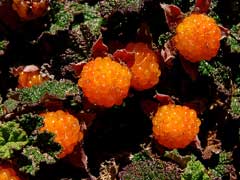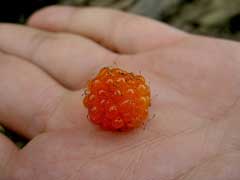 |
|
www.flickr.com/photos/bahamutzero |
 |
| www.flickr.com/photos/ecogarden |
Translate this page:
Summary
Physical Characteristics

 Rubus rolfei is an evergreen Shrub growing to 0.1 m (0ft 4in) by 0.6 m (2ft).
Rubus rolfei is an evergreen Shrub growing to 0.1 m (0ft 4in) by 0.6 m (2ft).
It is not frost tender. It is in leaf all year, and the seeds ripen from July to August. The species is hermaphrodite (has both male and female organs) and is pollinated by Insects.
Suitable for: light (sandy), medium (loamy) and heavy (clay) soils and prefers well-drained soil. Suitable pH: mildly acid, neutral and basic (mildly alkaline) soils. It can grow in full shade (deep woodland) semi-shade (light woodland) or no shade. It prefers moist soil.
UK Hardiness Map
US Hardiness Map
Synonyms
R. pentalobus Hayata is a synonym of R. rolfei J.E.Vidal
Plant Habitats
Woodland Garden Sunny Edge; Dappled Shade; Shady Edge; not Deep Shade; Ground Cover;
Edible Uses
Edible Parts: Fruit
Edible Uses:
Fruit - raw or cooked[183]. The yellow to orange-reddish fruit is up to 14mm in diameter[266].
References More on Edible Uses
Medicinal Uses
Plants For A Future can not take any responsibility for any adverse effects from the use of plants. Always seek advice from a professional before using a plant medicinally.
None known
References More on Medicinal Uses
The Bookshop: Edible Plant Books
Our Latest books on Perennial Plants For Food Forests and Permaculture Gardens in paperback or digital formats.

Edible Tropical Plants
Food Forest Plants for Hotter Conditions: 250+ Plants For Tropical Food Forests & Permaculture Gardens.
More

Edible Temperate Plants
Plants for Your Food Forest: 500 Plants for Temperate Food Forests & Permaculture Gardens.
More

More Books
PFAF have eight books available in paperback and digital formats. Browse the shop for more information.
Shop Now
Other Uses
Dye
A purple to dull blue dye is obtained from the fruit[168]. A good ground cover plant for a sunny position or deep shade[11]. It makes a firmly matted cover though it requires weeding for the first year or so[197]. Plants are best spaced about 60cm apart each way[208].
Special Uses
Food Forest Ground cover
References More on Other Uses
Cultivation details
Easily grown in a good well-drained loamy soil in sun or semi-shade[1, 11, 200]. Succeeds in deep shade. Plants are evergreen in most climates but they can lose their leaves in severe winters. Occasionally cultivated for its edible fruit, there are some named varieties[183]. 'Emerald Carpet' is an ornamental thornless form with orange berries that resemble small raspberries[183]. Plants in this genus are notably susceptible to honey fungus[200]. Rubus pentalobus Hayata is a synonym of Rubus rolfei J.E.Vidal The plant is heat tolerant in zones 9 through 7. (Plant Hardiness Zones show how well plants withstand cold winter temperatures.
Plant Heat Zones show when plants would start suffering from the heat.
The Plant Heat Zone map is based on the number of "heat days" experienced in a given area where the temperature climbs to over 86 degrees F (30°C).
At this temperature, many plants begin to suffer physiological damage. Heat Zones range from 1 (no heat days) to 12 (210 or more heat days).
For example Heat Zone. 11-1 indicates that the plant is heat tolerant in zones 11 through 1.) For polyculture design as well as the above-ground architecture (form - tree, shrub etc. and size shown above) information on the habit and root pattern is also useful and given here if available. An evergreen. A clumping mat former. Forming a dense prostrate carpet with a limited spread [1-2]. The root pattern is suckering with new plants from underground runners away from the plant [1-2].
References Carbon Farming Information and Carbon Sequestration Information
Temperature Converter
Type a value in the Celsius field to convert the value to Fahrenheit:
Fahrenheit:
The PFAF Bookshop
Plants For A Future have a number of books available in paperback and digital form. Book titles include Edible Plants, Edible Perennials, Edible Trees,Edible Shrubs, Woodland Gardening, and Temperate Food Forest Plants. Our new book is Food Forest Plants For Hotter Conditions (Tropical and Sub-Tropical).
Shop Now
Plant Propagation
Seed - requires stratification and is best sown in early autumn in a cold frame. Stored seed requires one month stratification at about 3°c and is best sown as early as possible in the year. Prick out the seedlings when they are large enough to handle and grow on in a cold frame. Plant them out into their permanent positions in late spring of the following year. Cuttings of half-ripe wood, July/August in a frame[200]. Division in early spring or just before leaf-fall in the autumn[200].
Other Names
If available other names are mentioned here
Native Range
TEMPERATE ASIA: Taiwan. TROPICAL ASIA: Philippines,
Weed Potential
Right plant wrong place. We are currently updating this section.
Please note that a plant may be invasive in one area but may not in your area so it's worth checking.
Conservation Status
IUCN Red List of Threatened Plants Status :

Growth: S = slow M = medium F = fast. Soil: L = light (sandy) M = medium H = heavy (clay). pH: A = acid N = neutral B = basic (alkaline). Shade: F = full shade S = semi-shade N = no shade. Moisture: D = dry M = Moist We = wet Wa = water.
Now available:
Food Forest Plants for Mediterranean Conditions
350+ Perennial Plants For Mediterranean and Drier Food Forests and Permaculture Gardens.
[Paperback and eBook]
This is the third in Plants For A Future's series of plant guides for food forests tailored to
specific climate zones. Following volumes on temperate and tropical ecosystems, this book focuses
on species suited to Mediterranean conditions—regions with hot, dry summers and cool, wet winters,
often facing the added challenge of climate change.
Read More
Expert comment
Author
Vidal.
Botanical References
11266
Links / References
For a list of references used on this page please go here
Readers comment